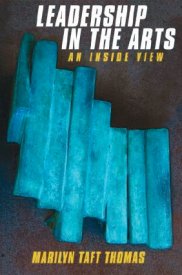LEADERSHIP IN THE ARTS – AN INSIDE VIEW

Marilyn Taft Thomas draws on her own experience and view of the arts to produce what is – as far as I’m aware – the first book on arts leadership. Its scope is ambitious: the contents page includes management issues such as staff supervision, fundraising, running meetings and budgeting, as well as issues of particular concern to leaders such as risk-taking, making decisions and working with a board.
The author is Professor of Theory and Composition at the Carnegie Mellon University School of Music. She has been Head of the School and of a number of other “arts units” (as she describes them). She knows the theory of what makes a good leader. For example, in a section called ‘Dealing in the Unknown’, she says, “Leadership is all about stepping back to view the big picture, considering the available options, and making sharp decisions in the best interests of your organization.” There are a few useful practical tips, for instance, on the ingredients of an effective strategic plan, but these areas are covered just as effectively, if not more so, in other general publications about leadership and management. What should have made this book distinctive is the author’s professional understanding of the particular challenges facing leaders in the arts. Marilyn Taft Thomas does not appear to take this seriously – indeed, her dedication states that her target audience is those who have run an arts programme, are presently doing so, think they’d like to do it or want to know more about the kind of people who become arts leaders and “those who just need a good laugh”. She states at the outset that her book “is based upon the premise that running an arts organization is counter-intuitive”. Artists are “a cantankerous lot”, she writes, “Every artist’s view of the world has you-know-who in the center.” Elsewhere she describes artists as “exceedingly difficult” and needing to be treated like two-year-olds with temper tantrums. You wonder why she chose the arts as a career or arts leadership as a subject.
There have been many books published about leadership – tap ‘Leadership’ into Amazon’s search engine and up comes a list of over a quarter of a million titles. Add ‘Arts’ to ‘Leadership’ and the number drops to under 8,000, of which almost all are about the ‘art‘ of leadership. So there is probably a real need for a book dealing authoritatively with the subject of leadership in the arts, and providing lessons from the arts to leaders in other fields such as the business, public and third sectors. Unfortunately, this is not that book.

Join the Discussion
You must be logged in to post a comment.